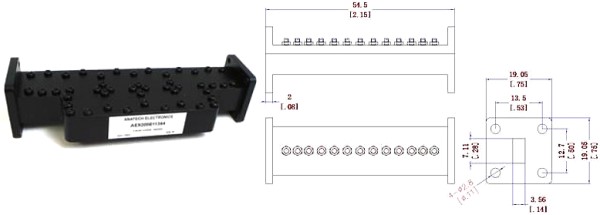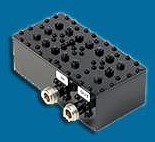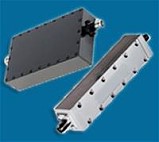|

Sam Benzacar of Anatech Electronics, an RF and microwave filter company, has published his
January
newsletter that features his short op-ed entitled "Some Good News on IoT
Wireless Protocol Incompatibility," which gives kudos to the many independent
IoT device manufacturers who are making their products with in[ter]compatible -
rather than incompatible - communications protocols. Was there no organized
industry collaboration effort for this before a group called "Open Connectivity
Foundation" introduced itself at CES 2020? Sam also mentions Amazon's new
900 MHz "Sidewalk" longer range, low datarate device protocol. Verizon believes
that 5G can eventually replace Wi-Fi, reversing the trend for small Wi-Fi cells
filling the bandwidth gap. Speaking of which, Wi-Fi 6E is right around the
corner, and now Bluetooth LE provides better audio quality.
A Word from Sam Benzacar
Some Good News on IoT Wireless Protocol Incompatibility
 By Sam Benzacar By Sam Benzacar
There's been some good news lately concerning the issue of incompatible short-range
wireless communication standards for IoT: A wave of collaboration among vendors,
so that products, even if using different protocols, can work together in the future.
This wouldn't have been a major problem if there were only two or three protocols
to contend with, but for IoT there are at least a half dozen, and the result has
been chaos and confusion for everyone, from designers to end users.
IoT really got its start in residential applications such as HVAC controls and
LED "smart" lighting, but currently includes everything from door locks, doorbells,
and digital assistants, to home surveillance systems, along with subwoofers and
complete whole-home audio systems, and more. As there has been no single communications
standard, manufacturers of these "edge devices" chose one (like ZigBee) and used
it for their entire product line. When Google entered the market with the Nest thermostat
it used a protocol it developed (Thread), and still others used Z-Wave. When Bluetooth
got mesh networking capability in Version 5.1, some manufacturers hopped on this
bandwagon, too. As more and more companies got into home automation, the result
was (and is) incompatibility between devices, making it almost impossible to control
all of them easier. Add to this the fact that all edge devices manufacturers all
have their own application software, and the result is like the typical home entertainment
scenario with multiple remotes sitting on an end table.
To solve this problem, the latest trend is the home automation gateway, which
accepts signals from multiple protocols, aggregates them, and sends the result to
Wi-Fi or a cable modem via Ethernet and then out to the Internet. They also include
support for iOS, Android, and Windows, and other features such as security services.
A good example is Samsung's SmartThings hub - but even it doesn't support Bluetooth,
doesn't support all features of all devices, and isn't all that easy to set up.
And of course, this adds yet another element to the mix, which creates the possibility
that the signals in some parts of a home may not be receivable by the gateway. In
short, this is clearly not the way IoT should be done, and the industry knows it.
So, a group called the Open Connectivity Foundation introduced itself at CES
2020 as being dedicated to "solving the IoT standards gap" with an approach and
accompanying specification to create a single open standard through which all devices
connect, including Wi-Fi, Bluetooth, ZigBee, Z-Wave, and Ant+. There's also Project
Connected Home created by Amazon, Apple, Google, and the ZigBee Alliance that plans
to develop an open-source connectivity standard to increase compatibility among
smart home products.
It will take at least a year before any of this bears fruit, but it's a good
start, and not a moment too soon, because IoT early adopters have already had enough
of trying to make IoT decipherable by mere mortals.
Amazon Creates Yet Another Wi-Fi Protocol
 As if here weren't enough
already, Amazon just introduced Sidewalk, which he claims will provide longer-range
than conventional Wi-Fi and Bluetooth using lower power (and thus increasing battery
life), allowing it to be used beyond the confines of a home or business. The company
is hoping that manufacturers will adopt it so users can replace Bluetooth, 5G, and
other standards. Sidewalk operates at 900 MHz with very low data rates and narrow
bandwidth, increasing range in building penetration. It also supports mesh networking.
As an example, it demonstrated a pet tracker called Fetch that looks like a key
fob and attaches to a pet's collar. When the tracker leaves a Geo fenced area, you're
notified on a smart phone app. As if here weren't enough
already, Amazon just introduced Sidewalk, which he claims will provide longer-range
than conventional Wi-Fi and Bluetooth using lower power (and thus increasing battery
life), allowing it to be used beyond the confines of a home or business. The company
is hoping that manufacturers will adopt it so users can replace Bluetooth, 5G, and
other standards. Sidewalk operates at 900 MHz with very low data rates and narrow
bandwidth, increasing range in building penetration. It also supports mesh networking.
As an example, it demonstrated a pet tracker called Fetch that looks like a key
fob and attaches to a pet's collar. When the tracker leaves a Geo fenced area, you're
notified on a smart phone app.
Verizon Thinks It Can Replace Wi-Fi with 5G
 In a bold statement during
a Citi investor conference, Verizon Executive Vice President and consumer group
CEO Ronan Dunne said "we don't see there's need for Wi-Fi in the future because
we have a more secure network environment (5G). We have much higher performance
criteria and we have the ability to hand off sessions, etc.., so fully deployed,
there are environments in which public Wi-Fi will be eliminated in favor of millimeter
wave because of security, reliability, and service capabilities." Also during the
event, the company noted that it is already working on repeaters and nodes for indoor
environments so they can cover them with 5G. In a bold statement during
a Citi investor conference, Verizon Executive Vice President and consumer group
CEO Ronan Dunne said "we don't see there's need for Wi-Fi in the future because
we have a more secure network environment (5G). We have much higher performance
criteria and we have the ability to hand off sessions, etc.., so fully deployed,
there are environments in which public Wi-Fi will be eliminated in favor of millimeter
wave because of security, reliability, and service capabilities." Also during the
event, the company noted that it is already working on repeaters and nodes for indoor
environments so they can cover them with 5G.
Bluetooth LE Audio Delivers Better Audio Quality
 The latest version of Bluetooth,
called LE Audio, is designed to deliver better audio quality, support for hearing
aids, lower power consumption because of lower bit rate, and the ability for an
unlimited number of uses to connect to one Bluetooth-enabled device through audio
sharing. The Bluetooth Special Interest Group is expected to release the specifications
in the first half of this year, so the first devices to support it were likely to
be available at the beginning of next year. The latest version of Bluetooth,
called LE Audio, is designed to deliver better audio quality, support for hearing
aids, lower power consumption because of lower bit rate, and the ability for an
unlimited number of uses to connect to one Bluetooth-enabled device through audio
sharing. The Bluetooth Special Interest Group is expected to release the specifications
in the first half of this year, so the first devices to support it were likely to
be available at the beginning of next year.
Soon to Come: Wi-Fi 6E
 In anticipation of an FCC
rulemaking concerning additional spectrum, the Wi-Fi Alliance is attempting to distinguish
the currently available Wi-Fi 6 (formally called IEEE 802.11ax) by coining the term
Wi-Fi 6E (the E is for extension). The point of this exercise is to let users recognize
that it incorporates all the features of Wi-Fi 6 with new benefits afforded by operation
at 6 GHz (rather than 2.4 and 5 GHz as it does today. When this band becomes available
it should offer greater bandwidth and thus wider channel sizes, less interference
with legacy devices, and higher data rates. In anticipation of an FCC
rulemaking concerning additional spectrum, the Wi-Fi Alliance is attempting to distinguish
the currently available Wi-Fi 6 (formally called IEEE 802.11ax) by coining the term
Wi-Fi 6E (the E is for extension). The point of this exercise is to let users recognize
that it incorporates all the features of Wi-Fi 6 with new benefits afforded by operation
at 6 GHz (rather than 2.4 and 5 GHz as it does today. When this band becomes available
it should offer greater bandwidth and thus wider channel sizes, less interference
with legacy devices, and higher data rates.
Getting Ready for 5G:
Anatech Electronics introduce New Ka band 30.5 GHz Waveguide Band Pass Filter.
Featuring a center frequency of 30.5 GHz, a bandwidth of 1000 MHz, an Insertion
Loss 1 dB Max, and a Power Handling is 20 watts.

Anatech Electronics Introduces a New Line of Suspended Stripline and
Waveguide Type RF Filters
Check out Our Filter Products



Cavity Band Pass Filters
LC Band Pass Filters Cavity Bandstop/Notch Filter
About Anatech Electronics
Anatech Electronics, Inc. (AEI) specializes in the design and manufacture of
standard and custom RF and microwave filters and other passive components and subsystems
employed in commercial, industrial, and aerospace and applications. Products are
available from an operating frequency range of 10 kHz to 30 GHz and include cavity,
ceramic, crystal, LC, and surface acoustic wave (SAW), as well as power combiners/dividers,
duplexers and diplexers, directional couplers, terminations, attenuators, circulators,
EMI filters, and lightning arrestors. The company's custom products and capabilities
are available at www.anatechelectronics.com.
Contact:
Anatech Electronics, Inc. 70 Outwater Lane Garfield, NJ 07026 (973)
772-4242
sales@anatechelectronics.com
Posted January 28, 2020
|



























 By Sam Benzacar
By Sam Benzacar As if here weren't enough
already, Amazon just introduced Sidewalk, which he claims will provide longer-range
than conventional Wi-Fi and Bluetooth using lower power (and thus increasing battery
life), allowing it to be used beyond the confines of a home or business. The company
is hoping that manufacturers will adopt it so users can replace Bluetooth, 5G, and
other standards. Sidewalk operates at 900 MHz with very low data rates and narrow
bandwidth, increasing range in building penetration. It also supports mesh networking.
As an example, it demonstrated a pet tracker called Fetch that looks like a key
fob and attaches to a pet's collar. When the tracker leaves a Geo fenced area, you're
notified on a smart phone app.
As if here weren't enough
already, Amazon just introduced Sidewalk, which he claims will provide longer-range
than conventional Wi-Fi and Bluetooth using lower power (and thus increasing battery
life), allowing it to be used beyond the confines of a home or business. The company
is hoping that manufacturers will adopt it so users can replace Bluetooth, 5G, and
other standards. Sidewalk operates at 900 MHz with very low data rates and narrow
bandwidth, increasing range in building penetration. It also supports mesh networking.
As an example, it demonstrated a pet tracker called Fetch that looks like a key
fob and attaches to a pet's collar. When the tracker leaves a Geo fenced area, you're
notified on a smart phone app.  In a bold statement during
a Citi investor conference, Verizon Executive Vice President and consumer group
CEO Ronan Dunne said "we don't see there's need for Wi-Fi in the future because
we have a more secure network environment (5G). We have much higher performance
criteria and we have the ability to hand off sessions, etc.., so fully deployed,
there are environments in which public Wi-Fi will be eliminated in favor of millimeter
wave because of security, reliability, and service capabilities." Also during the
event, the company noted that it is already working on repeaters and nodes for indoor
environments so they can cover them with 5G.
In a bold statement during
a Citi investor conference, Verizon Executive Vice President and consumer group
CEO Ronan Dunne said "we don't see there's need for Wi-Fi in the future because
we have a more secure network environment (5G). We have much higher performance
criteria and we have the ability to hand off sessions, etc.., so fully deployed,
there are environments in which public Wi-Fi will be eliminated in favor of millimeter
wave because of security, reliability, and service capabilities." Also during the
event, the company noted that it is already working on repeaters and nodes for indoor
environments so they can cover them with 5G.  The latest version of Bluetooth,
called LE Audio, is designed to deliver better audio quality, support for hearing
aids, lower power consumption because of lower bit rate, and the ability for an
unlimited number of uses to connect to one Bluetooth-enabled device through audio
sharing. The Bluetooth Special Interest Group is expected to release the specifications
in the first half of this year, so the first devices to support it were likely to
be available at the beginning of next year.
The latest version of Bluetooth,
called LE Audio, is designed to deliver better audio quality, support for hearing
aids, lower power consumption because of lower bit rate, and the ability for an
unlimited number of uses to connect to one Bluetooth-enabled device through audio
sharing. The Bluetooth Special Interest Group is expected to release the specifications
in the first half of this year, so the first devices to support it were likely to
be available at the beginning of next year.  In anticipation of an FCC
rulemaking concerning additional spectrum, the Wi-Fi Alliance is attempting to distinguish
the currently available Wi-Fi 6 (formally called IEEE 802.11ax) by coining the term
Wi-Fi 6E (the E is for extension). The point of this exercise is to let users recognize
that it incorporates all the features of Wi-Fi 6 with new benefits afforded by operation
at 6 GHz (rather than 2.4 and 5 GHz as it does today. When this band becomes available
it should offer greater bandwidth and thus wider channel sizes, less interference
with legacy devices, and higher data rates.
In anticipation of an FCC
rulemaking concerning additional spectrum, the Wi-Fi Alliance is attempting to distinguish
the currently available Wi-Fi 6 (formally called IEEE 802.11ax) by coining the term
Wi-Fi 6E (the E is for extension). The point of this exercise is to let users recognize
that it incorporates all the features of Wi-Fi 6 with new benefits afforded by operation
at 6 GHz (rather than 2.4 and 5 GHz as it does today. When this band becomes available
it should offer greater bandwidth and thus wider channel sizes, less interference
with legacy devices, and higher data rates. 





